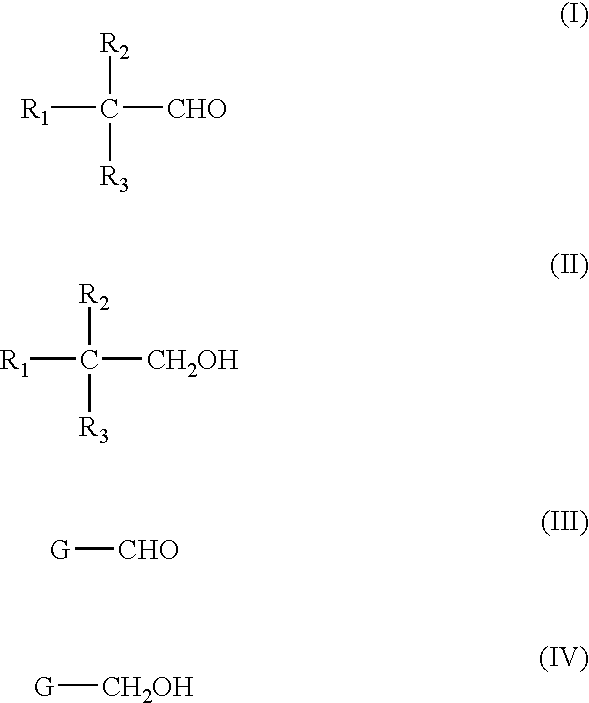Liquid phase catalytic hydrogenation process to convert aldehydes to the corresponding alcohols
- Summary
- Abstract
- Description
- Claims
- Application Information
AI Technical Summary
Benefits of technology
Problems solved by technology
Method used
Image
Examples
example-2
Hydrogenaiton of Benzaldehyde
A 1.0 g quantity of the catalyst (CuO / ZnO / Aluminium oxide) in 50 ml methanol was placed in a 300 ml capacity Parr reactor. The contents were treated with hydrogen at 170.degree. C., under pressure of 400-500 psig for 2-3 hrs. Cooled to room temperature, depressurized, followed by the addition of 10.0 g of benzaldehyde, in 50 ml of methanol. Hydrogenation was carried out at 170.degree. C., under a pressure of 400-500 psig, for 2-3 hrs. The conversion of benzaldehyde was 100% providing 100% selectivity of benzyl alcohol, the desired alcohol product.
example-3
Hydrogenation of 4-Hydroxybenzaldehyde
A 1.0 g quantity of the catalyst (CuO / ZnO / Aluminium oxide) in 50 ml methanol was placed in a 300 ml capacity Parr reactor. The contents were treated with hydrogen at 170.degree. C., under pressure of 400-500 psig for 2-3 hrs. Cooled to room temperature, depressurized, followed by the addition of 10.0 g of 4-hydroxybenzaldehyde, in 50 ml of methanol. Hydrogenation was carried out at 170.degree. C., under a pressure of 400-500 psig, for 2-3 hrs. The conversion of benzaldehyde was 100% providing 100% selectivity of 4-hydroxybenzyl alcohol, the desired alcohol product.
example-4
Hydrogenation of Isobutyraldehyde
A 1.0 g quantity of the catalyst (CuO / ZnO / Aluminium oxide) in 50 ml of methanol was placed in a 300 ml capacity Parr reactor. The contents were treated with hydrogen at 170.degree. C., under pressure of 400-500 psig for 2-3 hrs. Cooled to room temperature, depressurized, followed by the addition of 10.0 g of isobutyraldehyde, in 50 ml of methanol. Hydrogenation was carried out at 170.degree. C., under a pressure of 400-500 psig, for 2-3 hrs. The conversion of isobutyraldehyde was 100% providing 100% selectivity of isobutyl alcohol, the desired alcohol product.
PUM
| Property | Measurement | Unit |
|---|---|---|
| Temperature | aaaaa | aaaaa |
| Percent by mass | aaaaa | aaaaa |
| Pressure | aaaaa | aaaaa |
Abstract
Description
Claims
Application Information
 Login to View More
Login to View More - R&D
- Intellectual Property
- Life Sciences
- Materials
- Tech Scout
- Unparalleled Data Quality
- Higher Quality Content
- 60% Fewer Hallucinations
Browse by: Latest US Patents, China's latest patents, Technical Efficacy Thesaurus, Application Domain, Technology Topic, Popular Technical Reports.
© 2025 PatSnap. All rights reserved.Legal|Privacy policy|Modern Slavery Act Transparency Statement|Sitemap|About US| Contact US: help@patsnap.com



